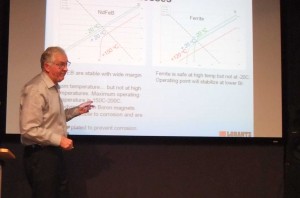On Monday September 14th 25 members and visitors gathered at the SAE Institute in South Melbourne, and after a short AGM (see separate report) Michail Barabasz of Lorantz Audio gave a presentation on “The Anatomy of the Loudspeaker Driver”.
Michail started by mentioning that he often heard comments about a speaker’s inadequacies when the issue was, in fact the room. He then went into a brief explanation of room effects and ways to separate the speaker performance & room effects by the use of software like Room Eq Wizard, a free room analysis program.
He then moved on to his main topic – loudspeaker drivers, and their construction.
He covered the choice of magnet material – options being neodymium, samarium-cobalt, alnico or ferrite, covering the pluses and minuses of the various types. He noted that commonly ferrite is used, as it has the best tradeoff of cost, performance, and temperature range.
He then described examples of the type of machinery used to make magnets and voice-coils covering bobbin material and wire types (round or rectangular) discussing fill factor. Rectangular should be better, but with offset winding round is very close to rectangular (less than 1dB less efficient), and it allows multiple layers – useful for where short coil length is desirable as in horn drivers.
He then described typical coil winding machinery, and moved on to the options with magnet structures – discussing overhung and underhung voice-coils, and then suspension design.
Then followed a description of the manufacturing of magnet structures, and the properties and use of ferrofluid were discussed.
A couple of different types of magnetizer machines were described– static and pulse types, and their pros and cons explained (speed of process vs optimum flux geometry).
He then went on to discuss cones, covering shape and materials, outlining the challenges of designing for the car industry when at Plessey – which was a low cost high volume market with products to be used in a harsh environment.
Cone materials were described as to their suitability vis-a-vis strength, audio performance and cost. Paper, plastic, fabric, metal, ceramic, or sandwich were nominated as options.
Which is better, Michail asked. He postulated that paper was a comfort material. He explained that when the cone material distresses each type exhibits a different tone. He indicated a preference for paper, fabric, or a sandwich type.https://s3-ap-southeast-2.amazonaws.com/aesmel/Hugh+Dean+August+2015.mp3
He then described his work with RMIT PhD candidate David Featherstone on Finite Element Analysis and the insights it provides – describing solutions to surround problems, and cone problems.
Michail then covered measuring methods, including the Kippel measurement system and identifying stresses in the cone, bobbin and surrounds.
He went on to describe the manufacturing process for paper cones and the process of beating the mix to improve fibre cohesion – citing some of the advantages of paper as a cone material – control of mixture beating, selection of the best fibre types, ability to deposit the paper wherever we want, and “it’s got a nice top-end – not overly bright and has a minimum amount of colouration”.
Cone manufacture process and machinery at Plessey and Lorantz were described, as was the surround material and the characteristics of various surround profiles.
Finally Michail described the specifications of many different designs for use in a range of applications, highlighting design tradeoffs involved.
Michail’s presentation covered such a range of loudspeaker topics that it is difficult to imagine than there was anyone who came away from the meeting without learning more than a few new facts about the subject.
An audio recording of Michail’s presentation can be played or downloaded here
Thanks to Graham Haynes and his trusty Tascam for the audio recording.
Special thanks to the SAE Institute for providing the venue for our meetings.

